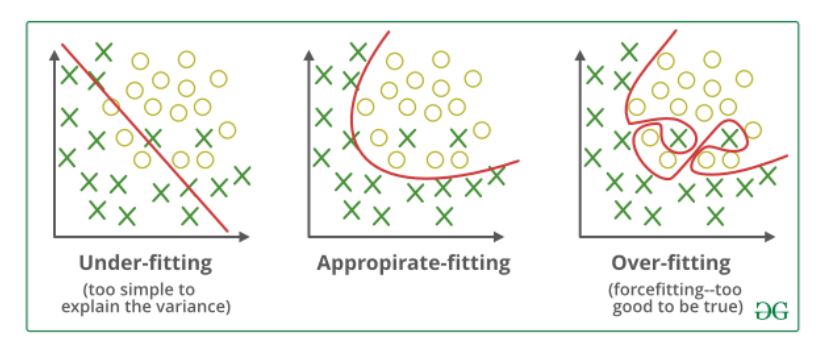Underfitting
-
when it cannot capture the underlying trend of the data. (It’s just like trying to fit undersized pants!).
-
when a model fails to capture important distinctions and patterns in the data, so it perfoms poorly- even with training data
( 데이터가 적기 때문에 패턴이나 특이점을 찾지를 못했어, 새로운 데이터는 물론, trainig 데이터에서도 poor performace를 보인다) -
정확률이 내려간다. (destroys the accuracy of our machine learning model)
언제? 일어나나?
we have fewer data to build an accurate model and also when we try to build a linear model with fewer non-linear data
- model를 하기에 data가 너무 작거나, 또는 non-linear data를 가지고 linear data를 만들려고 하거나 할때 생긴다.
how to fix?
Techniques to reduce underfitting:
Increase model complexity
- 모델를 더 복잡하게?
Increase the number of features, performing feature engineering
- feature를 늘린다.
Remove noise from the data.
- data로부터 noise를 줄인다.
Increase the number of epochs or increase the duration of training to get better results.
- epochs를 늘리거나 the duration of training을 늘린다.
Overfitting
- to be overfitted when we train it with a lot of data
just like fitting ourselves in oversized pants!). - 너무 많은 데이터로 training을 시켰을떄?
- a model matches the training data almost perfectly, but does poorly with validation or other new data
( trainig data 와는 완벽하게 매치가 되나 validation 이나 다른 새로운 데이터는 poor)
how to fix?!
Techniques to reduce overfitting:
- Increase training data.
- Reduce model complexity.
- Early stopping during the training phase (have an eye over the loss over the - training period as soon as loss begins to increase stop training).
- Ridge Regularization and Lasso Regularization
- Use dropout for neural networks to tackle overfitting.

